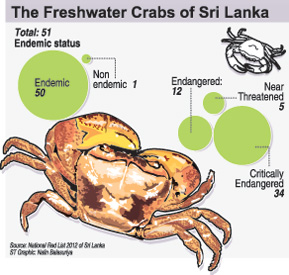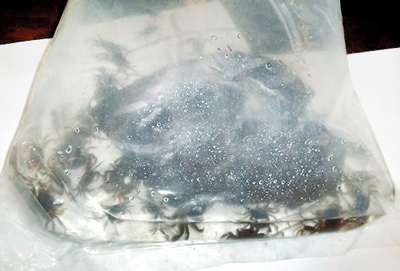News
Endemic freshwater crabs under threat, need protection: Experts
View(s):By Malaka Rodrigo
Not only elephants and leopards, but lesser known species such as freshwater crabs, that are jewels of Sri Lanka’s biodiversity, need to be protected, say experts.
On January 14, Customs at Katunayake Airport detected a consignment of 125 live freshwater crabs to be exported along with a consignment of other ornamental freshwater fish. The exporter who pleaded ignorance of their importance, was let off with a severe warning.

Custom’s Biodiversity Protection Unit’s Samantha Gunasekara confirmed this as the first detection of freshwater crabs, which were sent to the Dehiwala Zoo. Mr. Gunasekara, an expert on freshwater fish, said, though it is certain the crabs were collected from the wild, it was not prudent to return them to the wild, without knowing the exact location of their origin.
Many of Sri Lanka’s freshwater crabs show very restricted range and could lead to contamination of their pedigrees, as they could also be carrying diseases, hence the decision not to return them to the wild.
Sri Lanka’s freshwater crabs show the highest endemism for any group of animals, where, out of a total of 51 species, 50 are found only in our country. Up to 1994, only eight species of freshwater crabs were recognised as being from Sri Lanka, until an extensive exploration carried out by the National University of Singapore and the Wildlife Heritage Trust of Sri Lanka, resulted in the discovery of many new species, bringing this number to 51. At that time, all 51 freshwater crabs were endemic to Sri Lanka, elevating Sri Lanka as a Global Biodiversity Hotspot.
But it is unfortunate that this fauna group of high endemism also faces the highest threat of extinction. Nearly half the freshwater crabs – 23 species, are point endemics found only in single locations, making them extremely vulnerable to habitat loss, degradation and pollution. Most of them are restricted to Sri Lanka’s wet zone, where habitats are under the heaviest pressure. Assessing these risks, the recently launched National Red List marked 34 of them as “Critically Endangered”, with another 12 as “Endangered”.

Dinesh Gabadage and M.M. Bahir, perhaps the only experts on the Sri Lankan freshwater crabs, in their “Conservation Status of the freshwater crabs in the National Red List 2012,” suggest the need for urgent conservation actions.
According to these experts, many of the freshwater crabs occur outside the protected area network in private lands. Therefore, they suggest the need to engage the local community to protect these declining species, especially the point endemics that are restricted to single areas.
They also suggest maintaining a captive population for the Critically Endangered species. Perhaps, the stock handed over to the Dehiwala Zoo is a good opportunity to start a captive breeding programme, or Ex-situ conservation mechanisms.
Considering their rarity, there could be a demand for Sri Lanka’s freshwater crabs, from foreign collectors and breeders, warns Samantha Gunasekara.
As the collection from the wild adds to the list of their threats, he emphasises the need to strengthening the Fauna and Flora Ordinance further, to protect these kinds of neglected, yet highly important species that are the gems of Sri Lanka’s Biodiversity.
Follow @timesonlinelk
comments powered by Disqus















